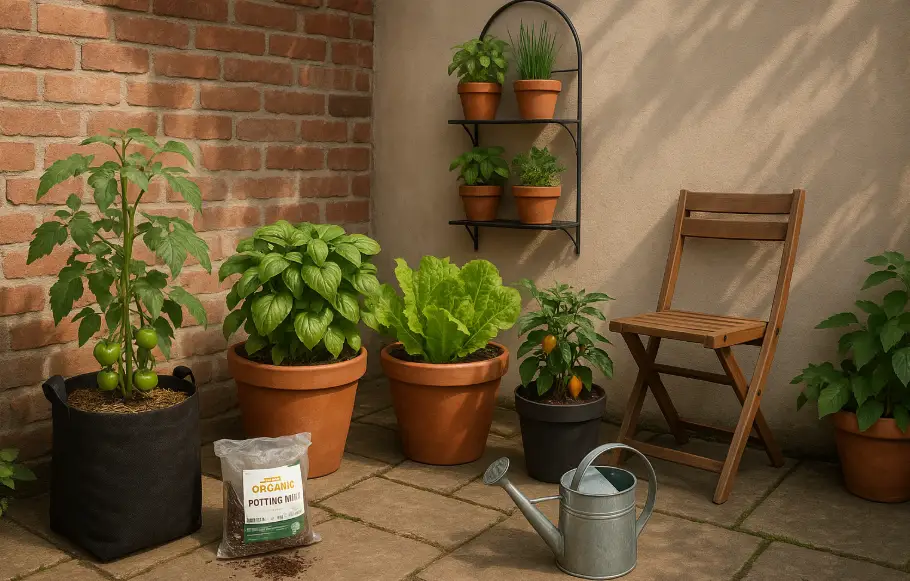Container Gardening in the City: Best Soil, Pots, and Tips for High-Yield Urban Harvests
No yard? No problem. Container gardening lets you grow fresh herbs, veggies, and flowers right from your balcony, windowsill, or rooftop.
It’s one of the most flexible and efficient ways to garden in urban spaces and with the right soil, containers, and a few smart techniques, even a tiny patio can yield big results.

Why Container Gardening Works in Urban Spaces
Container gardening is a perfect fit for city life. Here’s why it thrives where space is tight:
Flexibility: Move containers to follow the sun or avoid harsh weather
Water Efficiency: Conserve water and minimize waste
Pest Control: Fewer ground pests and easier to manage
Low Maintenance: No digging, tilling, or heavy equipment required
Whether you’re growing a single basil plant or an entire salad garden, containers put control in your hands.
Choosing the Right Pots for Urban Gardening
| Container Type | Pros | Cons |
|---|---|---|
| Plastic Pots | Lightweight, durable, budget-friendly | May overheat in full sun |
| Fabric Grow Bags | Breathable, root-friendly, collapsible | Dry out faster needs frequent watering |
| Self-Watering Pots | Low-maintenance, great for busy gardeners | Slightly more expensive |
| Ceramic/Clay Pots | Beautiful aesthetics, great indoors | Heavy, can crack if dropped |
🛠️ Top Pick: Try These Self-Watering Pots for Urban Patios
Best Soil Mixes for Container Success
The ideal mix:
🪴 Potting soil + compost + perlite or coco coir
This combo gives you:
Drainage
Moisture retention
Fluffy structure for root growth
⚠️ Avoid using garden soil in containers it compacts and suffocates roots.
🌱 Try this: Pre-Mixed Organic Soil for Containers – ready to plant, no mixing required.
Urban Container Gardening Tips for Higher Yields
Want to make the most of your small-space garden? Follow these pro tips:
✅ Choose compact or dwarf plant varieties
🧱 Add vertical supports (cages, stakes, trellises)
☀️ Rotate pots weekly to ensure even sun exposure
💧 Water consistently and mulch the top layer to prevent evaporation
🌿 Fertilize every 2–3 weeks with organic liquid feed or slow-release pellets
📓 Pro Tip: Keep a garden journal to track sun, watering, and growth patterns.

Best Vegetables and Herbs to Grow in Containers
| Plant | Container Size | Notes |
|---|---|---|
| Cherry Tomatoes | 5–7 gallons | Needs full sun, cage or stake |
| Bush Peppers | 3–5 gallons | Compact and highly productive |
| Lettuce | 6–8 inch depth | Prefers cooler shade, shallow roots |
| Basil & Mint | 8–10 inch pots | Easy, flavorful, grows indoors or out |
| Radishes | Shallow boxes | Fast harvest, great for small pots |
READ NOW : Growing Tomatoes in Pots: Best Tips, Pot Size, Soil, and Varieties for Container Success
Common Container Gardening Mistakes (and How to Fix Them)
| Mistake | Impact | Fix |
|---|---|---|
| Using garden soil | Poor drainage, root rot | Use lightweight potting mix |
| Overcrowding plants | Stunted growth | Space properly 1 plant per pot if needed |
| Inconsistent watering | Wilting, dropped fruit | Water regularly, mulch for retention |
| No drainage holes | Waterlogged roots | Always choose containers with drainage |
🛠️ Products Mentioned in This Guide
These are beginner-friendly tools that help you get better yields in smaller spaces.
FAQs About Container Gardening in the City
What size container is best for vegetables?
Use 5–10 gallon containers for tomatoes and peppers; 1–3 gallons works well for herbs and greens.
How often should I water container plants in the city?
During hot weather, daily watering is often needed. Consider self-watering pots or mulch.
What’s the best soil for containers?
Use a loose mix of potting soil, compost, and either coco coir or perlite.
Can I grow fruit trees in pots?
Yes! Try dwarf citrus, figs, or olives in 10+ gallon pots on balconies or rooftops.
Are fabric grow bags better than plastic?
Fabric bags provide better root health and airflow but dry out more quickly be prepared to water more often.
Grow Anywhere With the Right Setup
Container gardening opens the door to growing your own food even in the heart of the city. With a few well-placed pots, healthy soil, and smart plant choices, you can enjoy fresh harvests from your windowsill, balcony, or rooftop.






